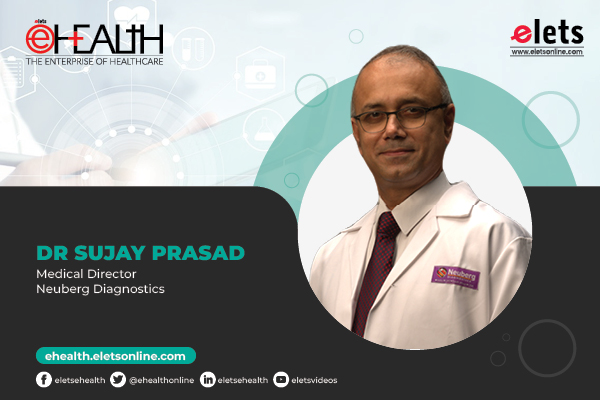
AI in diagnostics has the potential to increase access to high-quality healthcare and lower its cost by enabling healthcare professionals to choose the best course of treatment for their patients, shares Dr Sujay Prasad, Medical Director, Neuberg Diagnostics with Garima Pant of Elets News Network (ENN). Edited excerpts:
Your take on the current state of digital health infrastructure in the country.

On one hand, it is good that the digital health direction is being taken, but I think there’s a long way to go. Currently, I believe an effort toward digital health infrastructure is headed in the right direction. I must admit that it’s still fragmented, and both private and government driven projects are being done in isolation. There is no connection between the various efforts that are being put in, whether they are by private players, the ICMR, or the Government of India.
How is AI adoption in the diagnostic space, helping and improving diagnostic services?
When we talk of AI in its true sense, it is currently not applied in a significant way in diagnostics. In its current form, AI is more like a screening tool that guides the pathologist to decide what relevant and next-level investigation needs to be done.

There are two main benefits to using AI as a screening tool. The first one is that AI allows cases to be identified that we would have missed otherwise. Secondly, with the assistance of AI, we are able to guide patients and clinicians on minimising test requests and limiting them to more specific ones.
I think AI, regarding radiology images and analytics, has come a long way. The application of AI in radiology is far more advanced than in pathology or laboratory diagnosis. As we keep understanding laboratory data better, I think our ability to use AI as a tool to make it more meaningful will be significant.
But a word of caution is that AI is not the end. It’s one of many means to an end. So, whatever inputs we give the AI, including the bias of the human giving the inputs, will be expressed by the AI. So, we need to be very careful while providing source data to an AI algorithm.
What are the present lacunae in the diagnostic sector? And how do you see technology providing a solution to address these?
I think there are many lacunae regarding getting AI ready. Two big lacunae stand out. The first being, unstructured data, and the second, cleanliness of data. Another major lacuna is that, often, we are not asking the right questions. Data is available in abundance. The starting point of any meaningful data mining is asking the right questions. And asking the right questions is not a one-time effort. It gets refined over time, and it will take some time for all of us to understand and ask the right questions.
Talking about technology, all handwritten papers, prescriptions, and results are now being converted to digital data. Technology standards similar to DICOM are being used for laboratory data as well. In my view, the third and most significant one is the technology that brings data from various sources, whether it’s WhatsApp, Facebook, or Instagram, because there is a lot of health data residing in these social media portals as well. If platforms are built where we can aggregate information from various sources, I think there will be more meaningful insights.
What are the innovations in the diagnostic space that are crafting the future roadmap for the segment?
There are two major lines of innovation in the diagnostics space that are crafting the future roadmap of the segment, dataled innovations and traditional laboratory medicine innovations.
When we look at genomics and proteomics, the amount of data that is expressed from these technologies is quite large. Innovations will be coming if genomics becomes routine in the next couple of years, which is still a niche diagnostic tool right now. And, it needs to become a common tool for better diagnosis and management as a lot of information resides in the genes of an individual. So if we have to analyse such large data, innovations and data mining and analysis of genomic data will become an innovation in itself.
How do you see your organisation present positioning and future outlook in a digitally driven diagnostic ecosystem?
I think we’re well on our way toward a better understanding of that space because each of our labs and centers of excellence is generating a lot of data pertaining to routine health checks and diseases based on the diagnosis. We can deconstruct this data, gain knowledge, and then recombine it to add value. The more data we gather, the more health statistics start coming out, and we can build an infrastructure that meets the needs of the country. I think it is very clear that all of us need to manage information better and this is in the interest of the organisation, our community, and for the health of the nation and the world at large.
Be a part of Elets Collaborative Initiatives. Join Us for Upcoming Events and explore business opportunities. Like us on Facebook , connect with us on LinkedIn and follow us on Twitter , Instagram.












